Studying an atmospheric phenomenon called Schumann Resonance could reveal more data about how the solar system formed, while at the same time shedding new light on the physical properties of other worlds circling the Sun. The resonance was last year observed on other planets for the first time.
Schuman Resonance consists of electromagnetic waves that bounce between ground level and the lower ionosphere, and are produced by lightning flashes. On Earth, roughly 50 lightnings strike the surface every second, and the amount of electromagnetic waves they produce is significant.
As these waves bounce back and forth through the atmosphere, they produce a beating pulse-like signature that was first described mathematically by physicist Winfried Otto Schumann in 1952.
Last year, experts figured out that the Vector Electric Field Instrument (VEFI), installed by NASA aboard the US Air Force's (USAF) Communications/Navigation Outage Forecast System (C/NOFS) satellite, can detect Schumann Resonance on other planets.
Investigators now believe that it may be possible to use this capability to study the other planets in the solar system in depth, and even reveal more details about how the system itself formed and evolved.
The research describing the potential study technique was published in the May 1 issue of the esteemed Astrophysical Journal. The first author of the paper was NASA Goddard Space Flight Center space scientist, Fernando Simoes.
“The frequency of Schumann Resonance depends not only on the size of the planet but on what kinds of atoms and molecules exist in the atmosphere because they change the electrical conductivity,” the expert explains.
“So we could use this technique remotely, say from about 600 miles [965 kilometers] above a planet's surface, to look at how much water, methane and ammonia is there,” the investigator goes on to say.
“And if we can get a better sense of the abundance of these kinds of atoms in the outer planets. We would know more about the abundance in the original nebula from which the solar system evolved,” Simoes adds.
The trick is that instruments have to be fairly close to their target planets in order to study Schumann Resonance. Until new generations of spacecraft are built specifically for this purpose, scientists could investigate other planets as satellites already orbiting them begin their death plunge through the atmosphere.

 14 DAY TRIAL //
14 DAY TRIAL //